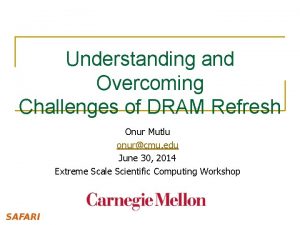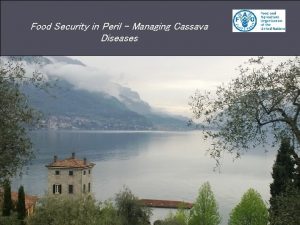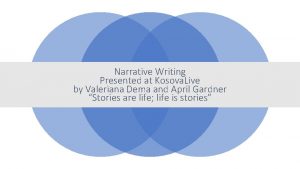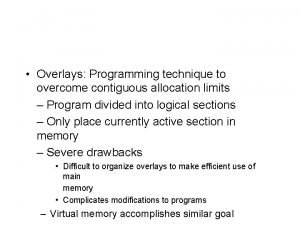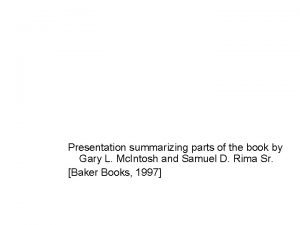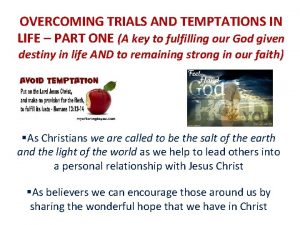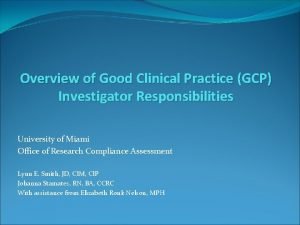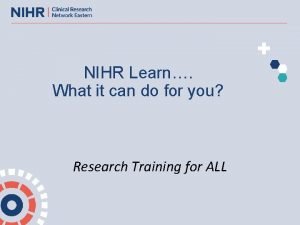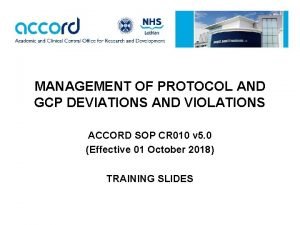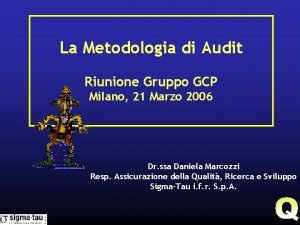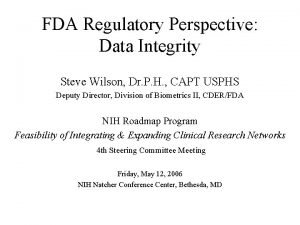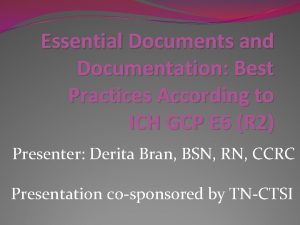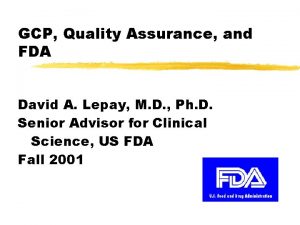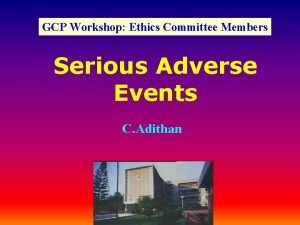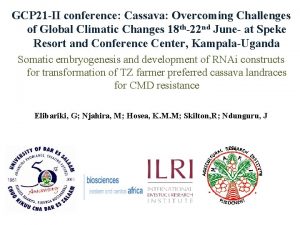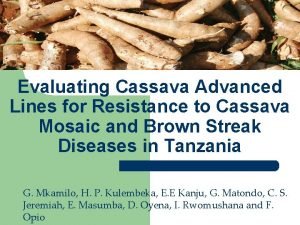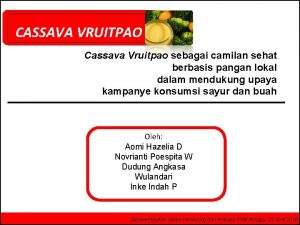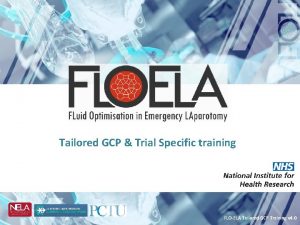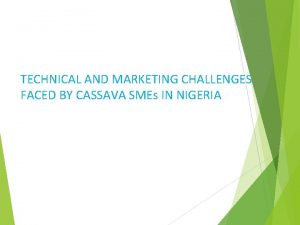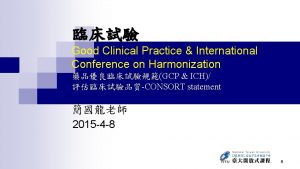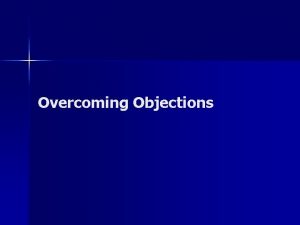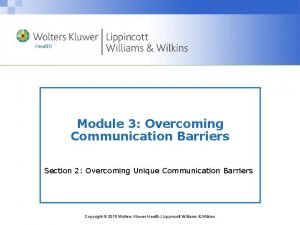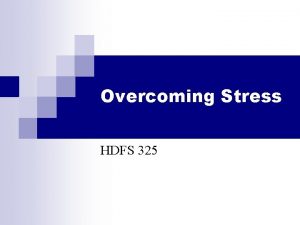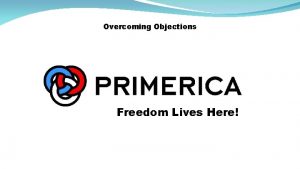GCP 21 II conference Cassava Overcoming Challenges of

































- Slides: 33

GCP 21 -II conference: Cassava: Overcoming Challenges of Global Climatic Changes 18 th-22 nd June- at Speke Resort and Conference Center, Kampala-Uganda Somatic embryogenesis and development of RNAi constructs for transformation of TZ farmer preferred cassava landraces for CMD resistance Elibariki, G; Njahira, M; Hosea, K. M. M; Skilton, R; Ndunguru, J

Cassava background • A root tuber crop, Euphorbiaceae family • Can strive within almost all climatic conditions • Harsh environs + high Tms, cassava precedes other African staple food cropsbanana, maize, rice, sweet potatoes, sorghum

• Suitable food crop for fight against hunger and poverty in Africa and sub-Saharan continent • TZ among the 10 producers in Africa, total calories per day from cassava =15% • However, among the major challenges facing cassava production is virus diseases. • CBSD and CMD -major concerns

• Most of TZ farmer preferred cassava (FPC) are highly yielding but are highly susceptible to CMD v. CMD incidences up to 72% , 2004 v. Survey 2005; TZ, 80% of cassava plants showed severe symptoms of CMD (Ndunguru et al. , 2005) v 2006; CMD alone-47% yield loss

However; • Due to the potentiality of this crop, there is a need for more efforts in fighting the viruses. • Genetic transformation (GT) to enhance resistance against viruses affecting cassava is inevitable.

Efforts to combat viral diseases-CMD & CBSD Conventional breeding Introgression Reseachers Farmers Researchers Phytosanitation Good Agricultural practices Biotechonology tools- G. T, genomics, MAs proteomics e. t. c

Further efforts USA LAB-ILTAB, DANFORTH CENTRE Technology transfer + Capacity building Collaboration EUROPEAN LABs (e. g ETH) AFRICA (IITA, NARS) Local farmers/ commercial? ?

• Despite other challenges of biotechnology tools such as GT; using • Successful GT of cassava requires üan efficient and effective transformation vectors for transgene delivery ü reliable protocols for transgenic plants recovery.

• Somatic embryogenesis (SE)among regeneration protocols for organized embryos of cassava • Others: organogenesis, FEC, suspension cultures • This study assessed some selected TZ farmer preferred cassava (FPC) for : Øsomatic embryo induction ability Ø sustainability of the S. E ØSubsequently regeneration of S. E to whole plant

7. CONVERSION TO PLANTS 6. MATURED EMBRYOS 2. GLOBULAR STAGE 1. CALLUS 3. HEART EXPLANT 5. COTYLEDON ARY 4. TORPEDO Somatic embryogenesis regime

• Also, transformation vector for transgene delivery was developed: 3 ds. RNAi constructs EACMV i. 2 constructs- Rep/ AC 1 ii. 1 construct- overlapping region of Tr. AP/AC 2 & REn/ AC 3 (AC 2/3) iii. ACMV constructs –still underway ØVector p. GSA 1285 (p. CAMBIA)

Induction of Somatic Embryos (SE) • Young unopened leaves /leaf lobes (2 wks old)- 20 -Cassava landraces–(Farmer Preferred) • MS supplemented with: v 4 -16 mg/L of 2, 4 -D, or Picloram v 2 -6 % (w/v) sucrose v 0 -1. 5 m. M Cu. SO 4 v. Casein hydrolysate • Incubation 28ºC, 16 hours photoperiod for 4 -8 weeks to produce somatic embryo cotyledons.

Maturation of somatic embryos • Globular stage somatic embryos on maturation media (MS salts) + • 2% (w/v) sucrose, 1 mg/L thiamine-HCL, 100 mg/L myo-inositol, 0. 01 mg/L, 2, 4 -D, 0. 5 mg/L BAP and 0. 5 mg/L GA 3. • Incubation- 3 to 6 weeks depending on the cultivar

Germination and plant recovery • Mature S. E, distinct root and shoot axes on root induction media • Several weeks incubations (up to 6 wks) • Acclimatization, transfer of plants into soil & maintenance in the screen house

Results • Generally 65% FPC were capable of S. E • Induction took btn 4 to 8 wks for landraces tested • Different performance under different media optimizations and light vs darkness

A SE 3 2 B 2 4 SAGALATO 1 MNAZI D C Regeneration Regime Of Cassava Landraces Via S. E

E E E F Root induction and maturation on MS media

2 wks old plantlets in the screen house

3 Cultivars Vs Sucrose and Cu. SO 4 conc.

m to go Ga zi na M a 1 ky ta 0 Ka ki ni No of S. E / total explants 70 Ka bi ba li nd am en o Ki ro ba Ki ng i Ra la ga Sa Cultivars Vs Copper Sulphate conc (m. M) 80 1. 5 60 50 40 30 20 10 0

Regeneration stages achieved by 20 FPC

Other observations • Explant status-health • Leaf lobe age-constant 2 wks but some had already opened • Lab and screen house conditions-esp Tm stability • Genotype

Transformation Vector for Transgene Delivery • RNAi constructs development Øds. RNA vector p. GSA 1285 (p. CAMBIA) • Construct plan: ihp. RNAi with 200 bp or 450 bp arms-sense and antisense • Two: (i) Target-AC 1 and (ii)AC 2/3 partial genes. EACMV

ihp. RNAi construct plan Big. III Hind. III Xho. I Bam. HI Sac. I EACMV (AC 1/5’or AC 2/3) Ca. MV 35 S (3 x) Sense Spe. I EACMV (AC 1/5’ or AC 2/3) Gus intron Antisense OCS terminator

Development of ihp. RNAi constructs • DNA Source: EACMV & ACMV -symptomatic cassava leaves (Delaporta et al. , 1983+ some few modifications) • Specific primers to confirm the above: • Primers: EAB 555/F & R -EACMV DNA B JSP 001 & JSP 002 -ACMV (AV 1/CP)

• Primers design for genes of interest sense + antisense Ref sequences: Gen. Bank AY 795983. 1 • STD cloning - p. GEMT-easy vector • Insert confirmation: Nucleotide. Sequence – Big. Dye™ Terminator technology, Bec. A-ILRI Hub, Nairobi-Kenya

Cloning into an Expression vector • Appropriate fragments released from p. GEMTeasy vector were cloned –into an expression vector • Screening of putative E. coli transformants – Colony PCR (bacterial) – Plasmid isolation/purification – Restriction digestion – Nucleotide sequence analysis

Nucleotide analysis…… • Pair of primers used for synthesis of respective fragments in PCR was used in sequencing + • Primers designed –flanking upstream and downstream of inserts/MCSs of the vector p. GSA 1285 • Nucleotide analysis BLAST (blastn) program, NCBI

Nucleotide sequence confirmation Similarity to EACMCV-AY 795983. 1 • Construct 1: 98% • Construct 2: 97% Similarity to EACMV-TZM-AY 795985. 1 • Construct 3: 96%

Conclusion • SE regeneration platform system now in place at MARI • Plantlets acclimatization- difficulty, still need some optimizations • Frequency of SE cotyledons recovery of SEs was good and % • Variables -might be genotype specific…(genotype analysis ongoing)

Perspectives • Constructs suitability & efficiency evaluation through GT of some few selected cultivars (FPC) • GT- Agrobacterium mediated via S. E • Further analysis Recommendation • More capacity building needed for R&D in LDCs –especially young Scientists & more collaboration

Acknowledgments • UDSM staff Dev Fund & UDSM Co. NAS World • • Bank Project- Ph. D Sponsor MBB Dept-UDSM TZ govt , Gates, Rockfeller Found, ILTAB, ASARECA +ALL donors-MARI Biosafety lab (II) MARI – Admin & Staff Bec. A –ILRI Hub & ABCF Supervisors: KMM Hosea, R. Skilton & J. Ndunguru The Ohio State Univ for expression vector to Dr Joseph USAID

Thank you all!
 Dram refresh failure
Dram refresh failure Cassava project
Cassava project Tuber plants
Tuber plants Cassava
Cassava Probiorefine 2021
Probiorefine 2021 Blessoff overcoming
Blessoff overcoming Overcoming barriers to employment
Overcoming barriers to employment Writing a narrative about overcoming a challenge
Writing a narrative about overcoming a challenge Hindrances to spiritual growth
Hindrances to spiritual growth Scripture about overcoming adversity
Scripture about overcoming adversity Overcoming glossophobia
Overcoming glossophobia Helen keller overcoming obstacles
Helen keller overcoming obstacles Coalescing holes in operating system
Coalescing holes in operating system Barriers of communication in pharmacy
Barriers of communication in pharmacy Booker seven basic plots
Booker seven basic plots Professor roz shafran
Professor roz shafran Overcoming the dark side of leadership
Overcoming the dark side of leadership Overcoming trials and temptations
Overcoming trials and temptations Investigator responsibilities gcp
Investigator responsibilities gcp Nihr gcp training
Nihr gcp training Gcp deviation
Gcp deviation Sae criteria gcp
Sae criteria gcp Audit gcp
Audit gcp Fda data integrity presentation
Fda data integrity presentation Essential document
Essential document Global carbon project
Global carbon project Gcp quality assurance
Gcp quality assurance The tokyo are on
The tokyo are on Global health network gcp
Global health network gcp Gcp aiesec
Gcp aiesec Gcp regler
Gcp regler Sae gcp
Sae gcp Global health gcp
Global health gcp Mathematical challenges for able pupils
Mathematical challenges for able pupils
